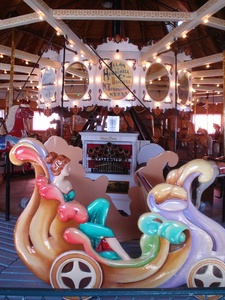 Love Seat - Larger Image
Love Seat - Larger Image
| Location |
| 180 Thompson St, North Tonawanda, NY 14120 |
| Summer Hours |
| Mon-Sat: 10:00am - 4:00pm |
| Sun: Noon-4:00pm |
| Phone / FAX |
| (716) 693-1885 / 743-9018 |
| [email protected] |
| Website |
| www.CarrouselMuseum.org |
| Reviews |
| Frommers Guide |
| InsiderPages.com |
Herschell Carrousel Factory Museum is a museum dedicated to preserving and presenting the history or the manufacturing of carousels and operated by the The Carousel Society of the Niagara Frontier
See Discussion and Comments, below.
Photos
 Museum Front - Larger Image
Museum Front - Larger Image 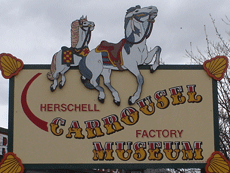 Welcome Sign - Larger Image
Welcome Sign - Larger Image 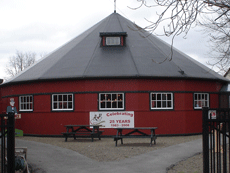 Round House - Larger Image
Round House - Larger Image 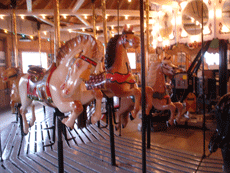 Lead Horse Row - Larger Image
Lead Horse Row - Larger Image
2010 Summer Events
June 7 - The Brass Ring Thing XIV Renaissance Festival
June 15 - Father's Day Celebration
June 25 - Adult Photography Course (Part of the Adult Art Series)
June 28 - Girl Scout Day
July 9 - Community Conversations with Kids
July 10 - Carrousel Chat (History of the Erie Canal)
July 21-25 - Classic Carrousel Camp (Grades K-2)
August 9 - Night Under the Stars (21+ Only)
August 14 - Teddy Bear Picnic
August 25 - Adult Water Color Course (Part of the Adult Art Series)
History
Located just 15 minutes north of Buffalo in North Tonawanda, the Herschell Carrousel Factory Museum is listed on both New York state and National Historic Registers.
The origin of carousels has been contributed to the Arabian_Peninsula in the 1100s, when crusaders brought back to Europe a game on horseback that the French eventually named carrousel. In the Middle Ages, it advanced to using wooden horses as a primitive training device to develop skills in the pursuit of becoming a knight.
By the end of the 18th century, carrousels became popular recreational devices, and could be found scattered over the European continent, eventually making their way to the United States after the Civil War.
Many of the most famous carousel artisans were German cabinetmakers and woodworkers who had immigrated to America, such as Gustav Dentzel (whose father had carved carousels in the old country), Charles Looff, Daniel Muller, and Russian-born but German-apprenticed M.C. Illions.
With the introduction of steam power and the Industrial_Revolution, amusement park carousels became the first thrill ride in the United States, intended only for adults. These dangerous and reckless mechanical wonders, moving at an astonishing 8 to 10 miles per hour, were decried by church and town leaders as corrupters of morals and dangerous to a rider’s health. This was the newfangled contraption that North Tonawanda resident, Allan Herschell, observed on a trip to New York City in the early 1880s. 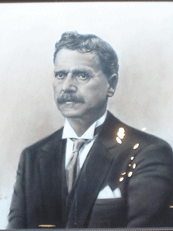 Allan Herschell - Larger Image Herschell, a Scottish immigrant and trained machinist, and his partner, James Armitage, had a thriving industrial business started in 1872 manufacturing steam engines and casting mechanical parts for the shipping and agriculture industries.
Allan Herschell - Larger Image Herschell, a Scottish immigrant and trained machinist, and his partner, James Armitage, had a thriving industrial business started in 1872 manufacturing steam engines and casting mechanical parts for the shipping and agriculture industries.
Since their company already produced engines and gearing, Armitage reluctantly agreed to Herschell’s suggestion that they attempt to manufacture some of their own carousel machines. Two years later in 1885, more than 50% of their business was carousel production.
Their factory location was ideally situated for the success of their new venture, since timber was shipped through the Great_Lakes to the local lumber industry running 5 miles up and down River Road in North Tonawanda.
There, a natural wind tunnel allowed the exposed lumber stacked 10 ft by 10 ft to continue air drying, and North Tonawanda processed more than 5 million board feet of lumber (12x12x1 inch equals 1 board foot) per year, much of it intricate millwork destined for the Victorian mansions in New York City.
Due to its ability to take paint and stain nicely, as well as its carving qualities, basswood or poplar was the wood of choice for carousel animal construction. The Armitage-Herschell animals were simple designs with real horsehair tails and glass eyes, but little other decoration. 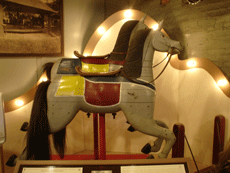 Armitage-Herschell style - Larger Image They operated on a railroad-type single track, and were called ‘rockers’ because they were mounted to move back and forth in a gentle rocking motion. The machines were designed to travel between communities, and became known as the ‘county fair’ style because the lack of detailed carving or painted decorations made them easy to move and maintain.
Armitage-Herschell style - Larger Image They operated on a railroad-type single track, and were called ‘rockers’ because they were mounted to move back and forth in a gentle rocking motion. The machines were designed to travel between communities, and became known as the ‘county fair’ style because the lack of detailed carving or painted decorations made them easy to move and maintain.
However, due to an economic recession, the company went into receivership in 1899, prompting Herschell to find new partners in his brothers-in-law, and form the Herschell-Spillman Company in 1900.
Herschell-Spillman still manufactured traveling machines, but now also created elaborate park carousels, including the newly patented ‘jumpers’ whose mechanism allowed horses to go up and down as if jumping, more exciting than the ‘stander’ animal, which was stationary with at least two feet on the ground.
The new company expanded their designs to include glass jewels and elaborate saddle designs, and, for the first time around 1904, menagerie animals (or animals other than horses) to complement their variety of horse styles. 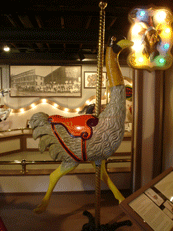 Menagerie Ostrich - Larger Image Another unique feature their animals displayed was a separate metal horseshoe.
Menagerie Ostrich - Larger Image Another unique feature their animals displayed was a separate metal horseshoe.
In 1913, Allan Herschell retired from the company due to continuing poor health, but didn’t stay away from the business for long. By 1916, with a newly hired crew of employees, he started competing with his former partners, who then changed their company name to Spillman Engineering.
For the next 40 years, the companies went head to head making machine improvements and offering credit-friendly payment plans for amusements. Machines could be ordered from small (about 24 animals, 2 across) up to 60 ft. in diameter, exhibiting 72 animals, 3 to 4 abreast, with a 2-step platform. The factory floor was painted with measurement markings for the 14 pie-shaped sections of each carousel width.
Herschell pioneered the mass-production of animals, though still maintaining the hand-carved process. To start, engineers created hand drawn blueprints for each animal, listing measurements, a materials list, and the tools needed.
In the wood room, where the drying of stacks had been completed, the wood was ‘dressed,’ meaning the surface was smoothed once with a jointer machine, then cut to the required thickness (usually 1-1/2 to 2 inches), and returned to the jointer machine to be ‘planed’, so all edges were smooth and uniform.
This was a critical first step, because controlled dried lumber was more stable, providing less weight, less cracking, and less disintegration. A good carver could determine the amount of moisture in the wood just by his touch, and for animals, that meant 6-12% moisture content. By comparison, furniture is usually 6-8% content.
The planed pieces then moved to the glue shop, where ironically, animal hide glue was used to adhere the individual wood strips into laminated surfaces for the rough outer dimensions to be carved. By laminating the body surface, the animal remained hollow for greater ease in shipping and assembly, but still retained strength.
Animal legs in particular were constructed using a ‘half lap’ joint, meaning a section was cut away on two pieces, always with the long grain for strength, and then glued. 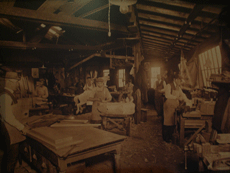 Carving Floor 1920s - Larger Image The most elaborate step was the body shop, where the work from the carving floor was assembled. Herschell had divided the carving floor into three areas. The apprentices were the beginners, responsible only for carving legs-maybe 6 per day. They might have started out sweeping the floors, sharpening tools, and just observing the more experienced carvers.
Carving Floor 1920s - Larger Image The most elaborate step was the body shop, where the work from the carving floor was assembled. Herschell had divided the carving floor into three areas. The apprentices were the beginners, responsible only for carving legs-maybe 6 per day. They might have started out sweeping the floors, sharpening tools, and just observing the more experienced carvers.
The journeymen worked on carving the body shapes and basic saddle work, completing approximately 1-1/2 horses per day. Then the animal moved to the master carvers to create the elaborate head and neck detail, again completing approximately 1-1/2 animals per day, and to assemble all the parts before being transported to the paint shop for decorating and varnish to protect the paint.
Before leaving the factory, every carousel was completely assembled and tested in the Roundhouse and then disassembled for shipping as far as India, Tahiti, and Mexico.
By the 1920s, a duplicating machine was introduced, which simplified the roughing out of animal bodies, and allowed the company to produce between 50 and 60 full machines each year by the time Herschell died in 1927.
Shortly after, the company introduced indestructible legs as replacements to those broken through being climbed on, then began offering new ‘half and half’ horses because the metal casting molds were less expensive. Eventually, all animals had even head and tail molds, marking the end of the hand-carved era.
But some features of the golden age of carousels can still be seen if you look. Every carousel has one ‘lead horse’, usually placed behind the chariot seat, or riding bench, if there is one. The lead horse is posed differently, slightly larger than any other animal on the carousel, and usually sports a wavy saddle blanket.
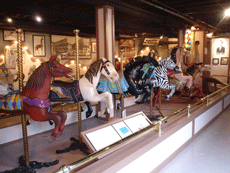 Romance Side - Larger Image Every animal on a carousel has a ‘romance side’. In the United States, this is the side on the animal’s right, facing outward as the machine rotates counter-clockwise, and on the animal’s left side in England where their machines, called ‘roundabouts’, travel clockwise. The logic was why waste time on something that is not seen?
Romance Side - Larger Image Every animal on a carousel has a ‘romance side’. In the United States, this is the side on the animal’s right, facing outward as the machine rotates counter-clockwise, and on the animal’s left side in England where their machines, called ‘roundabouts’, travel clockwise. The logic was why waste time on something that is not seen?
The company continued on in North Tonawanda, changing with the times to expand its offerings to ‘kiddie’ rides, still standard in parks today…kiddie boats, car rides, helicopters, kiddie carousels, and little dipper roller coasters, until 1959 when the company was sold.
In 1997, the current owner of the Allan Herschell Company assets auctioned the remaining inventory, archives and documents back to the museum’s parent body, the Carousel Society of the Niagara Frontier, which had been created in 1980 to return a North Tonawanda built carousel to the area. The original factory museum was opened to visitors in 1986 operating a 1916 Allan Herschell machine purchased in 1982.
Over 4000 carousels were built in American during the heyday, with only 148 hand-carved wooden machines still existing in tact. Of those, 71 were manufactured in one of the four North Tonawanda companies.
We hope you’ll take the opportunity to visit the exhibits at the Herschell Carrousel Factory Museum and put to test the museum’s motto “Once Around is Never Enough” on one of our carrousels.


